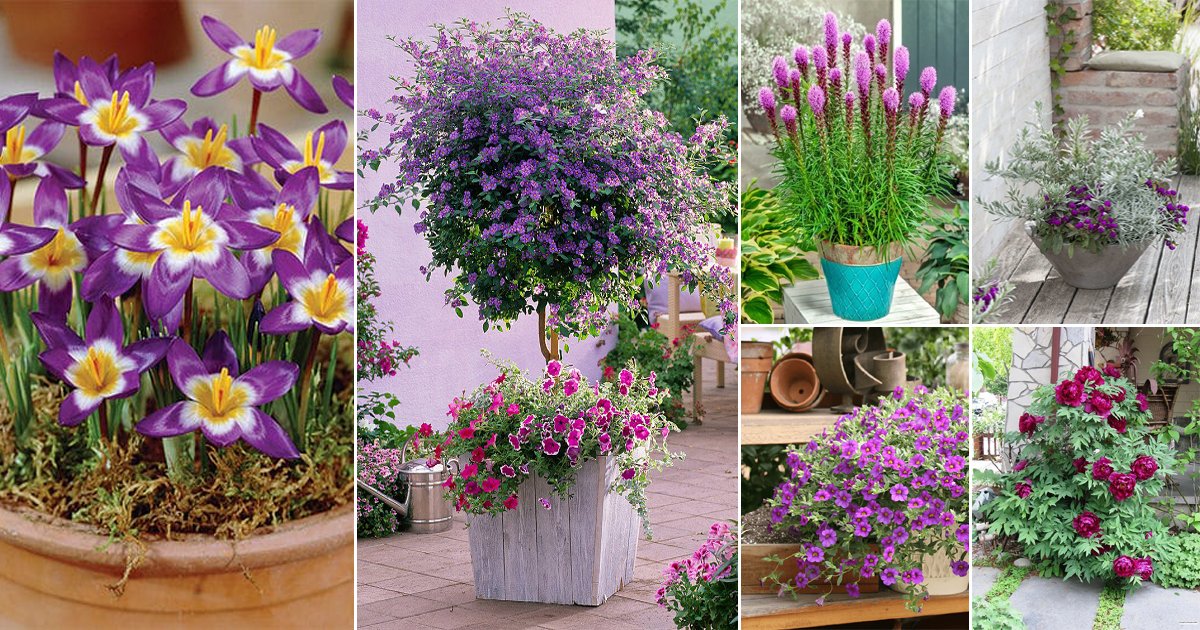Types of Purple Flowers
Purple flowers not only exude a regal allure but also infuse a touch of spirituality and imagination into your garden. Delve into our comprehensive list of the finest types!
Verbena
Verbena, with its botanical name Verbena, is a captivating flowering plant renowned for its vibrant clusters of small, trumpet-shaped blossoms that come in a myriad of stunning colors, including various shades of purple, pink, red, and white. This plant is native to North and South America, thriving in a range of climates, from arid regions to temperate zones. Verbena’s lush green foliage forms a charming backdrop for its profuse and long-lasting blooms, making it a popular choice for gardens, borders, and hanging baskets. Its nectar-rich flowers attract pollinators, including butterflies and bees, adding a delightful buzz of activity to any outdoor space. Verbena is celebrated not only for its visual appeal but also for its therapeutic properties in traditional herbal medicine, where it has been used for its potential healing benefits. With its versatility, resilience, and stunning floral display, Verbena remains a beloved and cherished addition to the world of ornamental and medicinal plants.
Read the Full Article Click on the Link Below
Purple Hibiscus
Purple Hibiscus, scientifically known as Hibiscus syriacus, is a remarkable flowering shrub that graces gardens with its exquisite, trumpet-shaped blooms in various shades of purple, ranging from deep violet to soft lavender. Originating from Asia, particularly China and India, this plant not only adds a burst of color to landscapes but also carries cultural significance. In many societies, including China and Korea, the Purple Hibiscus is a symbol of femininity, delicate beauty, and the fleeting nature of life. Its deciduous nature means that it sheds its leaves in the fall, emphasizing the ephemeral beauty of its flowers.
Typically growing to a height of 8 to 12 feet, this hardy shrub boasts lush green foliage that provides a striking backdrop to its vibrant, eye-catching blossoms. Purple Hibiscus is well-suited for a variety of growing conditions, thriving in well-drained soil and full sun. Its adaptability makes it a popular choice for gardens, where it adds a touch of elegance and charm.
Calla Lily
Calla lilies, scientifically known as Zantedeschia, are a botanical wonder known for their striking elegance and deep cultural symbolism. Originating from the marshlands of southern Africa, these graceful flowers have a rich history, dating back to ancient civilizations where they were revered for their unique beauty and associations with purity and rebirth.
One of the most distinctive features of the calla lily is its iconic trumpet-shaped bloom, called a spathe, which comes in a range of colors, although pure white is the most common. This pristine whiteness has earned calla lilies a place of honor in weddings and other ceremonies, symbolizing purity, innocence, and new beginnings.
However, calla lilies are not limited to just weddings; they are also used to convey profound messages in various life events. Their association with rebirth and transition makes them a thoughtful gift for someone embarking on a new journey or facing significant changes in life.
In the garden, calla lilies flourish in well-draining soil under partial to full sunlight, reaching heights of up to three feet depending on the variety. These perennial plants require consistent moisture but should be protected from overwatering, which can lead to root rot. They thrive in temperatures between 65°F and 75°F and should be shielded from frost.
Sweet Pea
Sweet Pea, known scientifically as Lathyrus odoratus, is a beloved flowering vine celebrated for its delicate and intensely fragrant blossoms. Originating from the Mediterranean region, this annual plant has captured the hearts of garden enthusiasts worldwide with its charming appearance and sweet perfume. Sweet Pea vines produce a profusion of flowers in various shades of purple, pink, red, white, and even bi-colors, creating a stunning visual spectacle.
The name “Sweet Pea” is not only a reflection of its delightful fragrance but also its endearing symbolism, often associated with blissful pleasure and gratitude. These dainty blossoms have long been a favorite in gardens and floral arrangements, adding an element of elegance and nostalgia.
Cultivating Sweet Pea requires some care and attention. They thrive in cool, temperate climates and prefer well-drained soil with full sun or light shade. Regular deadheading encourages continuous blooming throughout the growing season. Sweet Peas are well-suited for trellises, fences, and archways, where their climbing nature adds vertical interest and a touch of romance to garden landscapes.
Gloxinia
Gloxinia, scientifically known as Sinningia speciosa, is a mesmerizing flowering plant renowned for its trumpet-shaped, velvety blossoms that captivate a wide array of vibrant colors, including shades of purple, pink, red, and white. Native to the rainforests of South America, particularly Brazil, Gloxinia thrives in the dappled shade beneath the lush canopy, which makes it a popular choice for indoor cultivation in homes and greenhouses. Its lush, soft leaves form an attractive rosette, providing a lush backdrop for the striking blooms. The unique texture and vivid hues of Gloxinia petals make it a beloved choice for ornamental purposes, gracing homes, gardens, and floral arrangements with its enchanting beauty. Cultivating Gloxinia requires attention to proper care, including well-drained soil, consistent moisture, and protection from direct sunlight. Its ephemeral flowers may last for several weeks, creating a fleeting but unforgettable spectacle that underscores the plant’s charm and allure in the world of ornamental flora.
Conclusion
In conclusion, the world of horticulture is graced with a rich tapestry of purple flowers, each contributing its unique charm to gardens, landscapes, and floral arrangements. From the soothing fragrance of lavender to the majestic blooms of irises, the sweet elegance of lilacs, and the exotic allure of orchids, purple flowers captivate our senses and stir our emotions.
